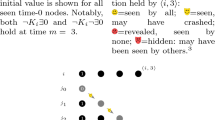Abstract.
The famous Fischer, Lynch, and Paterson impossibility proof shows that it is impossible to solve the consensus problem in a natural model of an asynchronous distributed system if even a single process can fail. Since its publication, two decades of work on fault-tolerant asynchronous consensus algorithms have evaded this impossibility result by using extended models that provide (a) randomization, (b) additional timing assumptions, (c) failure detectors, or (d) stronger synchronization mechanisms than are available in the basic model. Concentrating on the first of these approaches, we illustrate the history and structure of randomized asynchronous consensus protocols by giving detailed descriptions of several such protocols.
Similar content being viewed by others
Author information
Authors and Affiliations
Corresponding author
Additional information
Received: January 2002, Accepted: September 2002,
James Aspnes: Supported by NSF grants CCR-9820888 and CCR-0098078.
Rights and permissions
About this article
Cite this article
Aspnes, J. Randomized protocols for asynchronous consensus. Distrib. Comput. 16, 165–175 (2003). https://doi.org/10.1007/s00446-002-0081-5
Issue Date:
DOI: https://doi.org/10.1007/s00446-002-0081-5




